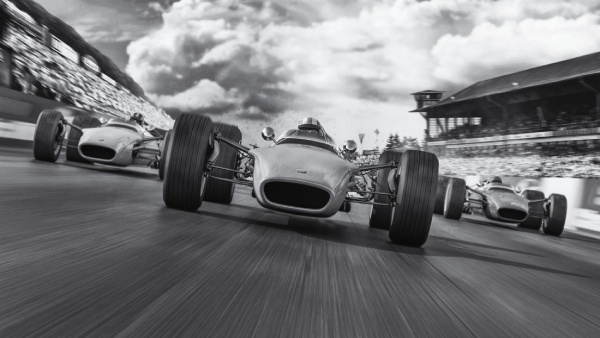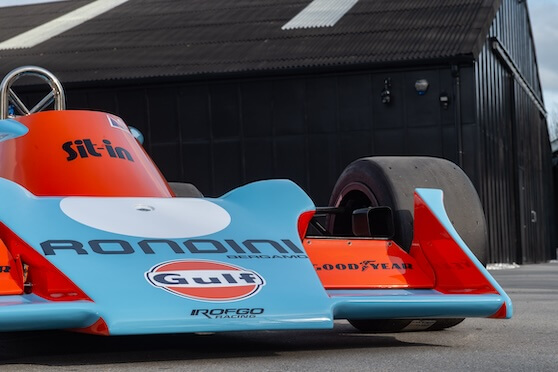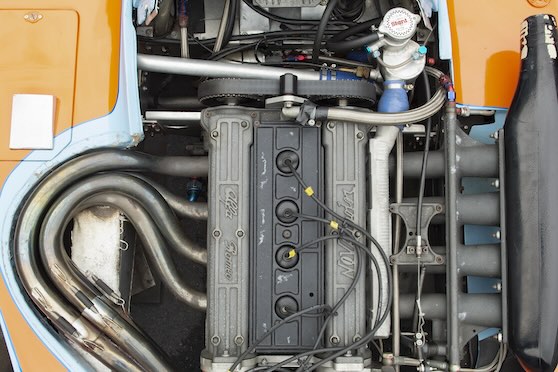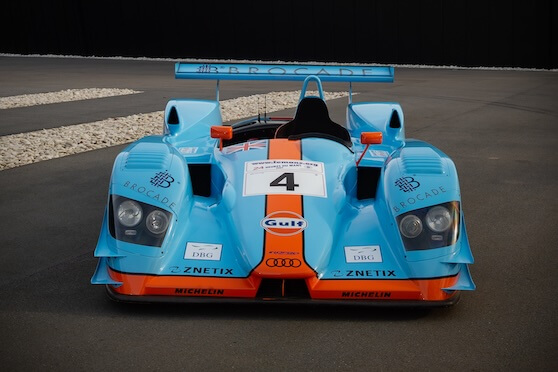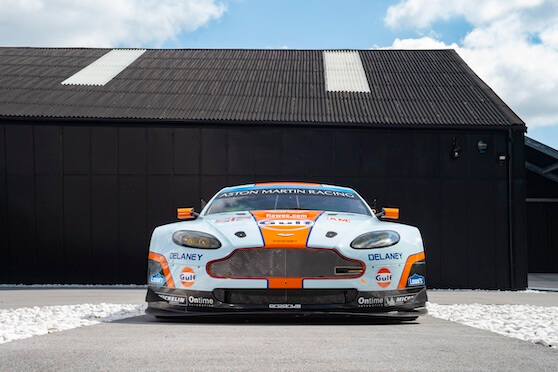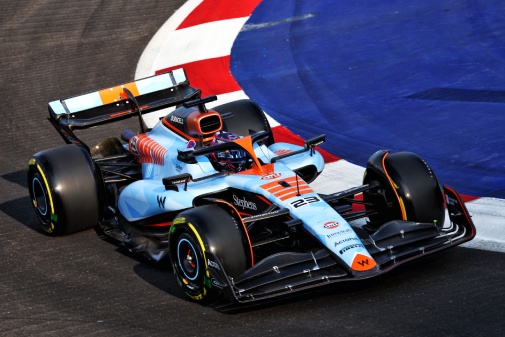
Technological Advancements That Evolved F1 Racing
Technological Advancements That Evolved F1 Racing
F1 is undoubtedly the most technologically advanced motorsport in the world and a lot has changed since the first Formula 1 World Championship Grand Prix in 1950. We’ve created a timeline of significant technological developments introduced by motorsport engineers.
Jump to year
1950s
Regulations dictated the use of up to a 2.5-litre naturally aspirated or 0.75-litre supercharged engine. But as the competition intensified, teams started to push the boundaries. Enter the V8 and V12 engines - the pinnacle of advanced engine design - boasting more power and higher top speeds.
Both types of engines, V8s and V12s, had been used in the sport since its early days. In fact, the inaugural Formula One World Championship in 1950 saw a mix of four-cylinder, six-cylinder, and eight-cylinder engines being used by different teams. One of the top teams, for example, used a V12 engine in their cars during the 1950s.
1952
F1 racing made hard-shell helmets mandatory for all drivers. Back in the day, helmets were made from humble materials like cloth-covered cork, which were soaked in glue for added strength. By the end of the decade, steel had become the material of choice for the ultimate protection on the track, although it was not until the 70s that helmet safety really increased.
1953
The Le Mans race was a true spectacle in 1953, and the winning car had a trick up its sleeve - disc brakes! As a result, F1 teams began to take notice and gradually made the switch from drum brakes to disc brakes. Not only did this increase the efficiency of braking, but it also reduced the risk of accidents. Disc brakes weren’t widely used in the sport until the mid-60s.
The first car to use disc brakes was, reportedly, in 1951 at the Spanish Grand Prix, however the technology was still in early stages. This meant the brakes were not as effective as the drum brakes most teams were using at the time. The first race won using disc brakes was in 1957 at the British Grand Prix.
1957
There was a revolutionary transformation in motorsport when the first rear-engined car made its debut in 1950, but had to retire on the first lap. The 1957 Monaco GP then saw the Cooper T43 make its first appearance and whilst other rear engined cars had been used in other racing series prior to this, the Cooper T43 was the first to be successful. With its superior weight distribution, lower centre of gravity, enhanced aerodynamics, and greater design flexibility, it quickly caught the attention of other teams due to its unmatched performance.
1962
The dawn of a new era in engineering was ushered in with the introduction of the first-ever monocoque chassis. A revolutionary design that would eventually supplant the traditional space-frame chassis, the monocoque was constructed from a single piece of aluminium, providing structural rigidity and shedding excess weight. The monocoque went on to incorporate other key components, such as suspension mounting points and fuel tanks, resulting in a seamless integration of form and function.
The concept of a monocoque chassis had been used in other racing series before then, such as in the aviation industry for building lightweight and strong aircraft structures. In racing, the monocoque chassis has become the standard design for all teams since the 1980s.
1968
F1 designers began to push the limits of what was possible through innovative aerodynamic designs. Aerodynamics had already been a consideration before 1968, but it was in that year that the first high-winged car was introduced, marking a significant step forward in the use of aerodynamics in the sport. The use of wings and spoilers became a pivotal turning point, as they were shown to drastically increase downforce and improve cornering speeds. It wasn't long before the first-ever F1 car to feature wings made its grand debut in 1968.
The success of the first high-winged car encouraged other teams to adopt similar designs, and by the early 1970s, nearly all race cars featured some form of aerodynamic wing or device.
1969
Slick tyres were a game-changer. With their smooth surface offering a larger contact patch to the track, they provided a significant boost to the cars' grip and performance. As a result, lap times improved dramatically, making for a more competitive and thrilling racing experience for fans.
1969
The introduction of the first-ever four-wheel-drive car was met with a major setback. Despite its cutting-edge design, featuring a 2.5 litre V8 Coventry Climax engine, this technological marvel was rendered obsolete due to regulations limiting Grand Prix cars to 1.5 litres from 1961 onwards.
There were some experimental four-wheel drive F1 cars before this. In 1961, a four-wheel drive car won the non-championship Oulton Park International Gold Cup. It was the only four-wheel drive car to win a race pre-1969.
1970
One innovation that turned the motorsports world on its head was the introduction of side-mounted radiators. They were first introduced to racing in the late 1960s, with some teams experimenting with the design in 1968 and 1969. However, it wasn't until the early 1970s that the use of side-mounted radiators became more widespread.
This revolutionary design challenged the conventional thinking of inboard brakes and overhead radiators and offered teams a new way to cool their engines. Before this development, teams had primarily used radiators in the nose, which had been the standard since F1's inaugural year in 1950.
1972
In response to mounting safety concerns, the first six-point harness seat belts were introduced. This innovation was a significant upgrade over the standard four-point harness, giving greater protection to drivers in the event of an accident. The six-point harness provided additional support to the pelvis and reduced the risk of submarining (sliding under the lap belt). The six-point harness was first introduced in motorsport in the late 1960s, with its use becoming more widespread in the 1970s. However, it was not until the 1990s that the FIA mandated the use of a six-point harness.
1977
Ground effects were first introduced in Formula 1 in the mid-1970s, but they became more prominent in the late 1970s and early 1980s. The concept of ground effects involved manipulating the airflow under the car to create a low-pressure area. This would pull the car down onto the track, providing unparalleled grip and stability, which allowed the cars to corner at much higher speed than before.
Teams quickly saw the potential of this innovation and began experimenting with designs to take full advantage of its benefits. The first race car to incorporate ground effects featured side skirts that sealed the gap between the car and the track, creating a ground-effect tunnel that generated massive amounts of downforce.
Ground effects were eventually banned in 1983 due to safety concerns and the high costs associated with developing and maintaining the technology.
1977
In the quest for more power, teams turned to a new innovation: the turbocharger. Replacing the supercharger as the primary method of boosting engine performance, turbochargers utilised the energy from exhaust gases to spin a turbine, forcing more air into the engine. The result? F1 cars equipped with turbocharged engines could produce more power than their naturally aspirated counterparts. Turbochargers were first introduced in the late 1970s, with Renault being the first team to successfully implement the technology in 1977.
1981
The introduction of carbon fibre composite materials to the chassis revolutionised car design, making them significantly lighter, stronger, and more rigid. This game-changing development transformed the way teams approached car design and allowed them to push the limits of performance. Carbon fibre composites were actually first used in motorsports in the late 1970s. However, their use became widespread in the 1980s with Mclaren pioneering them in 1981, creating the first to feature a carbon fibre monocoque.
1982
Active suspension systems were introduced, providing teams with the ability to fine-tune their cars' suspension for optimal handling and performance in real-time, based on the unique demands of each track. This breakthrough set the stage for the future of suspension design but was eventually banned in 1994 as fans felt it negated the individual skills of the drivers.
1984
Carbon-carbon brakes replaced traditional steel brakes, delivering enhanced stopping power and durability. The first car equipped with these brakes won a Grand Prix, and this victory paved the way for the widespread adoption of this new technology. However, their use was briefly banned in 1998 due to safety concerns, before being reintroduced in 1999. Since then, carbon-carbon brakes have been a standard feature.
1987
Traction control was introduced for the first time in F1 in 1987, automatically reducing power to the wheels, giving drivers more controlled acceleration, near-perfect starts and increased corner control. Not everyone was thrilled about the introduction of traction control as fans felt that it took away from the crucial element of driver skill. It was banned in 1994 but rose like a phoenix from the ashes in 2001, but was once again banned in 2004. Since then, the use of any form of traction control has been prohibited.
1989
The semi-automatic gearbox, also known as a paddle shift gearbox, replaced manual gearboxes in 1989 and enabled drivers to achieve faster and more precise gear changes. This innovative development represented a major leap forward in technology.
1993
Anti-lock braking systems (ABS) were another game-changing addition to the sport. First used by the Williams Racing team, it ensured there was no imbalance of brakes or wheel locking, giving drivers greater control on the track. It was banned in 1994, along with other driver aids such as active suspension and automatic gearbox, as they were seen to significantly reduce the importance of individual driver skill.
1997
A team introduced a steer-brake pedal, an invention that took the sport by storm. The new pedal allowed for better-controlled braking, with only one rear brake operating on the side of the car determined by the track. However, it proved to be a challenging transition for drivers who were still using a clutch pedal, as they now needed to master four pedals to implement this tricky invention.
2003
Safety became a top priority and the Neck Support device (HANS) was introduced after extensive development and testing. HANS consists of a carbon fibre U-shaped shoulder collar which is secured under the driver's safety belts and connected to the helmet by two elastic straps. HANS was intended to prevent the driver’s head from hitting the steering wheel if the car crashes and played a vital role in protecting drivers from tragic accidents. It was invented in the early 80 by a biochemical engineering professor and former racing driver Jim Downing and was first used in competitive racing in 1991, being made mandatory in 2003.
2009
Another key change was the introduction of KERS (Kinetic Energy Recovery System). This system allowed teams to convert braking energy into extra power, giving drivers an edge on the track. And that's not all - adjustable front and rear wings were also added to supercharge the car's aerodynamics, paving the way for even more innovations to come. This key change in the sport was made redundant and replaced years later.
2010
The F-duct, also known as the ‘driver-operated aerodynamic outlet’ or ‘blown ear ring’ made its debut in racing in 2010. The system involved the driver blocking an air vent in the cockpit with his knee. This would redirect air to the rear wing, increasing downforce and reducing drag, ultimately gaining a straight-speed advantage. Although quickly copied, the F-duct was banned by the FIA the following season, in 2011, and replaced with the DRS.
2011
The F-duct device was replaced with the all-new Drag Reduction System (DRS). It was designed to give drivers a serious advantage in overtaking, helping them increase their chances of that elusive wheel-to-wheel racing we all know and love. With the flick of a switch, the driver can open up a flap in the rear wing, reducing drag and increasing straight-line speed when they're within one second of the car in front. DRS set the stage for an exhilarating period in motorsport history.
2014
The FIA ushered in a new era of power with the introduction of 1.6-litre direct-injected turbocharged V6 units, replacing the old 2.4-litre V8 engines. These new engines allowed for kinetic and heat energy recovery systems, leading to developments and advancements in the years that followed.
2018
The FIA took a major step forward in terms of safety when they made the 'halo' mandatory for all race cars. Though it received a fair amount of pushback from drivers and fans who deemed it 'ugly' and 'unnecessary', the halo has been a lifesaver in the truest sense of the word. The flip-flop strap-shaped device offers drivers a shield in the event of a direct hit and protects them from debris. It's proven to save lives time and time again, with some incredibly close calls being caught on camera.
2020
Headlines were made with the revolutionary DAS (Dual Axis Steering) system. By changing the alignment of the front wheels on the fly, Lewis Hamilton was able to dominate the competition and take home his record-breaking seventh F1 championship. But as always in racing, the rules are constantly evolving. The DAS system was banned in 2021, leaving teams scrambling to find the next big breakthrough.
Discover more about Gulf’s motor sport history
Gulf has always had a keen interest in motorsport - it's in our veins. Find out more about our rich motorsport history.


